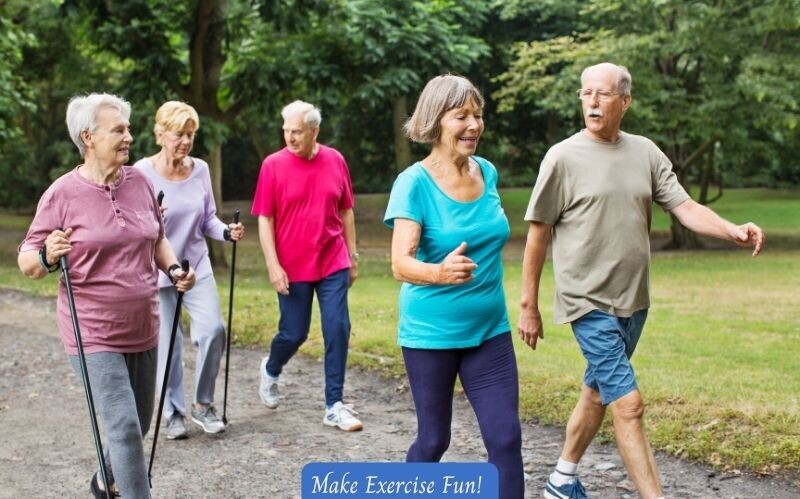Adopting a healthy and active lifestyle isn’t just about short-term goals like losing weight or fitting into your favorite outfit. It’s about long-term benefits, such as improving your overall well-being, maintaining your independence as you age, and adding quality years to your life. Whether you’re just starting your journey or getting back on track, small daily steps can lead to lasting change. Let’s dive into practical ways to make health and fitness a permanent part of your routine.
Why Health and Fitness Matter at Every Age
Living a healthy lifestyle is crucial at any age, but it becomes even more vital as we grow older. Regular physical activity helps:
- Feel stronger and more energetic.
- Improve mobility, balance, and flexibility.
- Sleep better and manage stress.
- Prevent or manage the risk of chronic conditions like heart disease, diabetes, and arthritis.
- Maintain cognitive function, keeping your brain sharp.
- Stay active and independent as you age.
According to the Centers for Disease Control and Prevention (CDC), adults over sixty-five should aim for 150 minutes of moderate aerobic exercise per week, coupled with muscle-strengthening activities at least two days per week.
Steps to Make Health and Fitness a Lifestyle
1. Set Realistic Goals
Big changes can feel overwhelming. That’s why it’s better to start small. Focus on easy wins you can stick with.
Start Small and Build Momentum
Setting achievable goals is key to staying motivated. Instead of aiming for a complete transformation overnight. Focus on smaller, sustainable changes.
This post contains affiliate links. If you click on and purchase through one of those links, you won’t pay a penny more, but we’ll get a small commission, which helps keep our website operating. Thanks! As an Amazon Associate, I earn from qualifying purchases.
A.-Move More Each Day
For example, even 10 to 15 minutes of movement each day makes a difference.
Start walking for 10 minutes a day, then gradually increase the duration.
- Walk around the block.
- Chair yoga or stretching.
- Rebounding on a mini trampoline.
- Light strength training with resistance bands.
The key is consistency – not intensity.
B.-Choose Real Food
Fuel your body with whole, natural foods. Incorporate one new healthy meal into your week, then build on it.
Listed below are four simple guidelines:
- Eat more vegetables, fruits, and whole grains.
- Include lean protein like chicken, beans, or fish.
- Choose healthy fats like olive oil or nuts.
- Limit processed snacks and sugary drinks.
Remember: it’s not a diet—it’s a way of life.
Incorporate one new healthy meal into your week, then build on it.
Consistency matters more than perfection. Celebrate small wins.
C.-Stay Hydrated
Drinking water helps with energy, digestion, and mental clarity. Keep a water bottle nearby and sip throughout the day.
Check Current Price Here for the Price of a Owala FreeSip Insulated Stainless Steel water bottle.
2. Find Activities You Enjoy
The best exercise is the one you’ll actually do. Experiment with different activities to find what excites you.
Make Exercise Fun
Some options include:
- Walking: A low-impact way to stay active and enjoy nature.
- Dancing: Great for cardio and coordination.
- Yoga or Tai Chi: Excellent for flexibility, balance, and relaxation.
- Swimming: Perfect for joint-friendly exercise.
Engage in activities with friends or join community classes to stay motivated.
3. Create a Routine
Schedule Your Health. Consistency is easier when fitness is part of your daily schedule. Start with one or two habits and build from there.
Here are some tips:
- Morning: Stretch, hydrate, and eat a healthy breakfast
- Midday: Light movement (like a walk or bounce on a rebounder)
- Evening: A healthy dinner and wind-down time (avoid screens before bed)
Choose a specific time each day for physical activity and stick to it. Lay out your workout clothes or plan meals in advance to avoid skipping.
4.Fuel Your Body with the Right Foods
A healthy diet complements your fitness goals. Focus on these nutrition tips:
- Eat Whole Foods: Incorporate fruits, vegetables, whole grains, lean proteins, and healthy fats.
- Stay Hydrated: Drink plenty of water throughout the day.
- Limit Processed Foods: Reduce sugar, sodium, and unhealthy fats.
For seniors, it’s essential to include calcium-rich foods (like leafy greens and dairy) and vitamin D to support bone health.

5. Make It Social
Invite a friend or partner to join you. Even a simple daily check-in can help keep you motivated.
Accountability makes a big difference. Share your goals with a friend or join a group with similar aspirations. You can also:
- Keep a journal to track your progress.
- Use a fitness app to log meals and activities.
- Reward yourself for hitting milestones with a relaxing massage or a new fitness gadget.
Overcoming Common Barriers
“I Don’t Have Time”
Break exercise into 10-minute sessions throughout the day. A brisk walk after each meal can add up to 30 minutes of activity.
“It’s Too Expensive”
Health and fitness don’t require costly gym memberships. Walking, home workouts, and resistance bands are budget-friendly options.
“I Lack Motivation”
Focus on how you’ll feel after exercising—energized and accomplished. Surround yourself with positive influences and remember your “why.”
Benefits of a Healthy Lifestyle
Transforming your habits pays off in numerous ways:
- Increased energy and reduced fatigue.
- Better sleep and improved mood.
- Enhanced ability to perform daily tasks.
- Greater confidence and sense of accomplishment.
The Mayo Clinic highlights that regular exercise even reduces the risk of depression and improves cognitive function, which is vital as we age.
Don’t Let Setbacks Stop You
Everyone has days when they skip a workout or eat something less than healthy. That’s part of life.
Instead of giving up, simply start again the next day.
Progress isn’t about perfection. It’s about persistence.
Track Your Wins—Big and Small
Keeping track of your progress helps you stay motivated.
Celebrate things like:
- Walking longer than last week
- Cooking a healthy meal
- Feeling more energized
- Lowering blood pressure or cholesterol
Write it down in a notebook or use a simple app to stay encouraged.
According to the American Heart Association, being more active may help you:
- Lower your blood pressure.
- Boost your levels of good cholesterol.
- Improve blood flow (circulation)
- Keep your weight under control.
- Prevent bone loss that can lead to osteoporosis.
Make Health and Fitness a Lifestyle That Lasts
If you want to feel strong, energized, and independent for years to come, make health and fitness a lifestyle—not a temporary fix.
It doesn’t have to be overwhelming. Start with small, manageable changes, and gradually build habits that feel natural and enjoyable. Whether you’re walking with friends, cooking a nutritious meal, or dancing in your living room, each step brings you closer to a healthier, happier you.
You don’t need to overhaul your entire life overnight. Just start with one healthy choice today. Then another tomorrow. These small steps add up to big, lifelong results.
You’ve got this—one day, one healthy habit at a time.
Sources:
- Centers for Disease Control and Prevention: Physical Activity Basics
- American Heart Association: Why Is Physical Activity So Important for Health and Wellbeing?
- Mayo Clinic: 5 Tips for Walking Your Way to Better Health
Disclaimer: If you have any concerns or questions about your health, you should always consult with a physician or other healthcare professional. No content on this site should be substituted for direct medical advice from your doctor or other qualified healthcare practitioner. The information contained here is for informational purposes only. It is from my research and personal experience.
Related Posts
10 Healthy Habits for Long-Term Weight Loss
17 Ways to Keep Motivated as You Keep Getting Fit
13 Healthy Habits for the Heart; a Heartfelt Journey to Wellness

